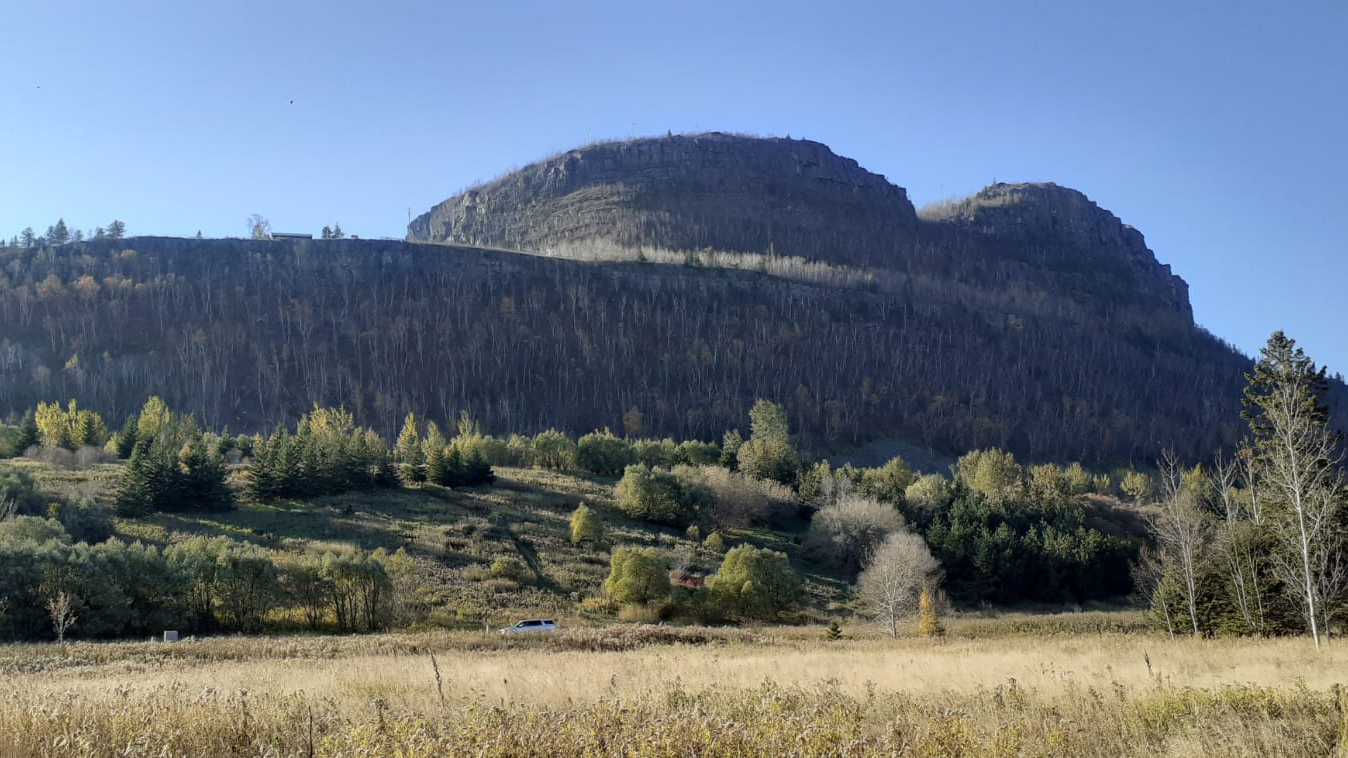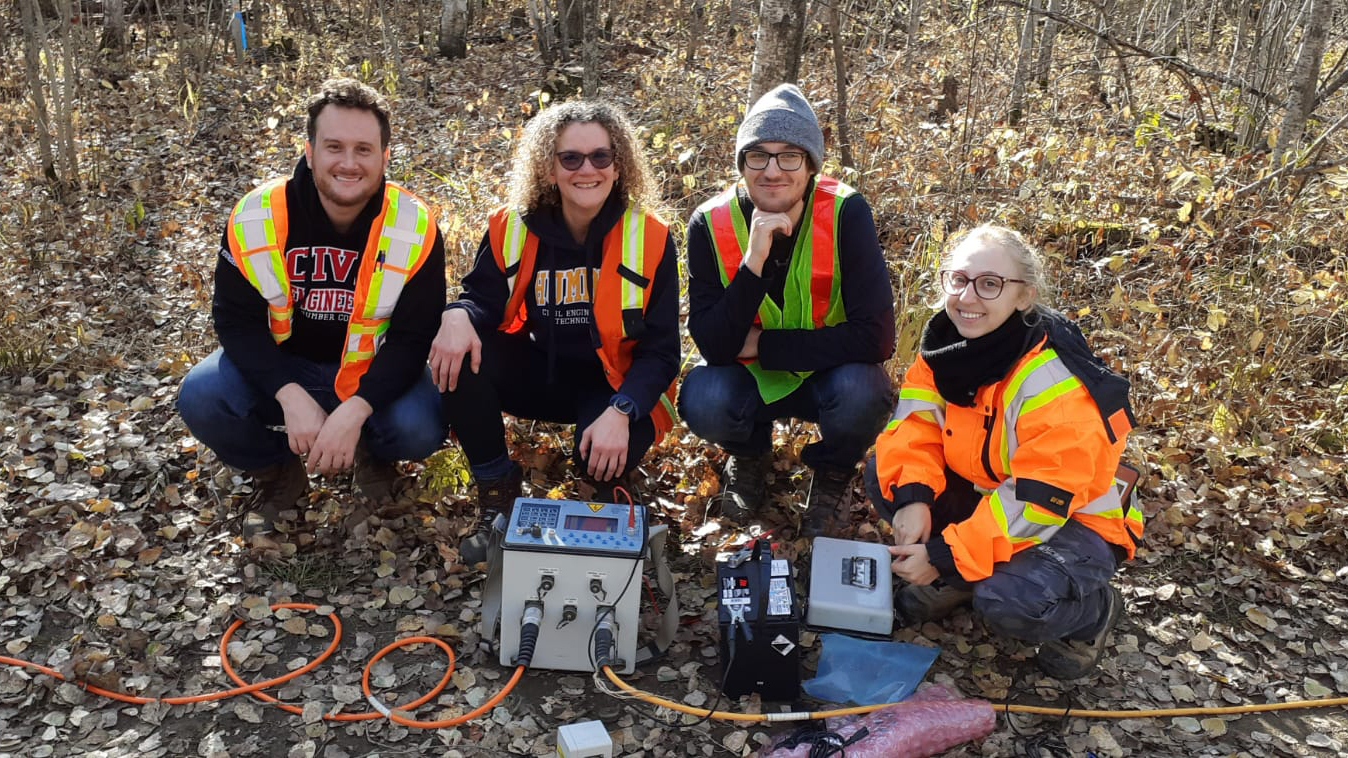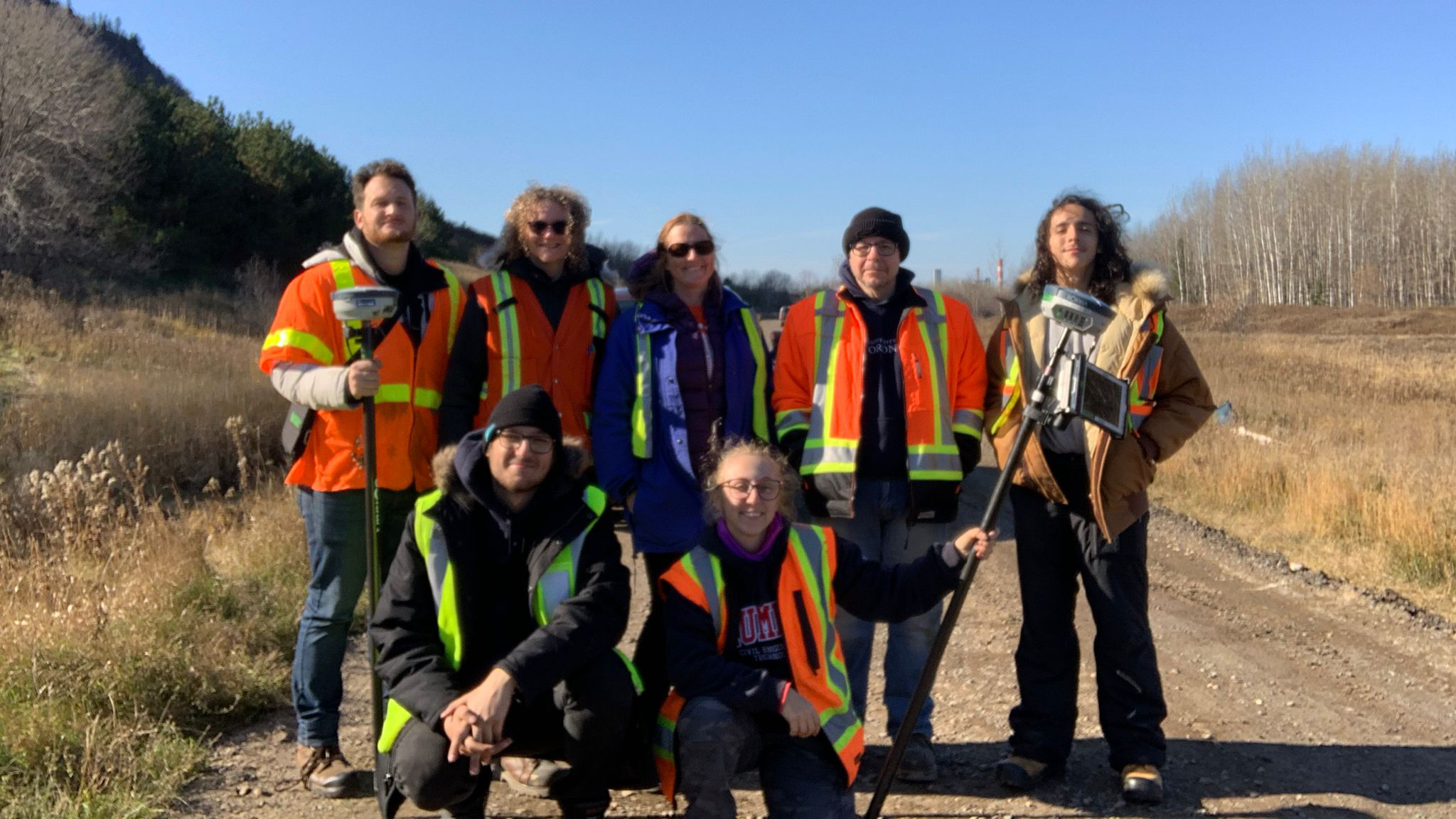Caring for the Thunderbird’s Nest: Geophysical and Machine Learning Solutions to Characterize and Monitor Inequitable Exposures to Ground and Air Pollution

By Esha Rana
Almost two years ago, Fort William First Nation (FWFN) made a post on Facebook about the high clusters of leukemia in their community, specifically in an area south of Thunder Bay. The people living in that 2.5-kilometer stretch were experiencing 500 times more incidents of leukemia than the national average. What was most concerning was that kids between 0 and 15 years old were also plagued by the disease. This is not an age range when leukemia occurs often.
The community got in touch with Melanie Jeffrey, professor at the University of Toronto, who teaches Indigenous studies and is involved with toxicology and pharmacology in the human biology department. Through her, Fort William First Nation got in touch with Maria Jacome, PhD, P.Geo, professor at the Faculty of Applied Sciences & Technology (FAST) at Humber College and with Cristina Amon ScD, P.Eng., professor at the University of Toronto and Head of the Advanced Thermal/Fluid Optimization, Modelling and Simulation (ATOMS) Lab (Department of Mechanical and Industrial Engineering).
The project started with a conversation about trying to figure out what happened and pinpointing the sources of contamination in the area. Four possible points were discovered from where the contaminants may be reaching the groundwater which could be affecting the community. The investigators wrote a proposal to the National Sciences and Engineering Research Council of Canada (NSERC) and were granted $360,000 from the College and Community Social Innovation Fund.

Inspiration for conducting social innovation research project
Maria was looking for community partners or industry partners even before the possibility of the project opened. She explains:
“In collaboration with the University of Toronto, my students at Humber and I were implementing a geophysical technology in Simcoe County. Not only did we successfully map the contamination flow that was going through the aquifer, but we could also map other contaminant flows that were migrating in different directions. The community we were working with were excited about these results and so were we. We wanted to apply the methodology and technology to other communities, so when we got in touch with Fort William First Nation and Professors Cristina Amon and Melanie Jeffrey, both at the University of Toronto, we found the perfect match. We had the technology, the experience, the students, the equipment and finally, we had a community that needed support in figuring out what was happening in their area.”
—Maria Jacome, PhD.

Project goals
The goals of this interdisciplinary collaboration are five-fold:
- Work in an ethic of care and reciprocity with FWFN and the land
- Fully assess the industrial area to characterize it and identify prevention, management and remediation methods of the polluted sites
- Co-produce culturally appropriate and accessible information to enable informed local decision-making now and in the future
- Create pathways of ethical engagement with Indigenous community-driven research agendas for engineering students, enabling FWFN to become a “go-to, go through” community for student training on complex environmental problem solving
- Build a culturally safe nest to develop community capacity and mentor Indigenous students in environmental engineering and interdisciplinary studies in an Indigenous community setting
Research team

Maria Jacome teaches in the programs of Civil Engineering Technology and Bachelor of Engineering—the Built Environment. She holds a PhD in Earth Sciences and a Graduate Certificate in Environmental Sciences and Engineering. As a professor, she has supervised undergraduate and graduate students in applied geophysics and civil and environmental engineering. In the past few years, she has been using shallow geophysical techniques—in particular, the Ground Penetrating Radar (GPR) and Geoelectrical Profiling—for geotechnical and environmental applications. She has led a series of projects, involving the Department of Capital Development and Facilities Management at Humber College, the Toronto and Region Conservation Authority (TRCA), an NSERC grant working with Simcoe County, and DGI Geoscience.
Cristina Amon is Alumni Distinguished Professor, University Professor and Dean Emerita (2006-2019) of the Faculty of Applied Science and Engineering at the University of Toronto (UofT). She is the Scientific Director of the UofT’s Electrification Hub and Director of the ATOMS Laboratory. She has led the way in the field of computational fluid dynamics and the development of multidisciplinary multiscale hierarchical modelling, concurrent design and optimization methodologies for fluid and transport phenomena, with applications to biomedical devices, and thermal management of electronics, electric vehicles and renewable energy. She was also appointed to the Order of Canada and inducted into the Canadian Academy of Engineering, Royal Society of Canada, Hispanic Engineer Hall of Fame, Spanish Royal Academy and National Academy of Engineering.
When she was Dean of the UofT’s Faculty of Applied Science and Engineering, Cristina spearheaded the development of several innovative outreach programs to Indigenous communities. As such, it was almost natural for her to embark on a new project that would involve a First Nation’s public health and welfare.
Speaking on the impact of the project, Cristina says, “Through this project, we have created interdisciplinary bridges with the community in a nest of cultural safety and care. Besides making pollutant profiles visible and manageable, the research has the added value of using a mixed methodology that goes beyond a pure engineering approach. It brings together people from different backgrounds (i.e., colleges, universities, and the FWFN Community) and disciplines (e.g., social science, civil, mechanical, and chemical engineering, geophysics, human biology, Indigenous populations, and public health) to work in a culturally grounded Integrated Translation Knowledge framework. In addition, the results of this kind of study are meant to build local and Indigenous capacity to monitor and remediate lands, enabling community leaders to develop a regulatory framework based on Indigenous values for land use and to make evidence-based decisions to protect the health of current and future generations.”
Daniela Galatro is a chemical engineer with more than 20 years of experience in the design, optimization, start-up and operation of oil & gas, refining, petrochemical and chemical production plants, as well as flow assurance, data analysis and computer process modelling and simulation. A culture enthusiast, she has extensive experience abroad in Canada, Germany, Venezuela, China, Russia and other countries. In November 2020, Daniela joined the Department of Chemical Engineering and Applied Chemistry at the University of Toronto as an Assistant Professor, Teaching Stream. She teaches heat and mass transfer, data-based modelling for prediction and control, team strategies for engineering design, plant design and petroleum processing. She also conducts engineering education research and has recently developed hybrid approaches for modelling landfills and a novel model for predicting degradation in lithium-ion batteries.
As the co-applicant for this project, Daniela will transfer her experience to assess remediation and post-remediation monitoring techniques in contaminated sites. She will also provide expertise in machine learning methods employed for prediction purposes. She is excited about engaging with fieldwork and acknowledges the quality of their experience till now, “This experience has been incredibly satisfying. I’m working with an extraordinary multidisciplinary team of researchers and students and with the community of Fort William First Nation. The community is the centre of this project. We are applying a hybrid technology that combines engineering, human biology, Indigenous populations and public health approaches in an integrated translation framework with the ultimate goal of caring about a sacred site, the Anemki Wajiiw, also known as Mount McKay.”
Melanie Jeffrey is a settler of English, Irish and Scottish descent from Parry Sound, on the traditional territory of the Anishinaabeg in the Williams Treaties area. Her more recent ancestors have roots across Ontario, from Red Lake to Oakville. She is an assistant professor at the Centre for Indigenous Studies & Human Biology at the University of Toronto and has two postdoctoral fellowships to her name—one from Waakebiness-Bryce Institute for Indigenous Health and the other from the University of Toronto in Fundamental Neurobiology. Her graduate degree is a PhD. in Pharmacology and Toxicology (University of Toronto, 2014).
Working with Indigenous persons and their allies guides Melanie’s path in teaching and research. Elders have suggested that it is her role is to be a bridge between Indigenous and western ways of knowing in the academy. Melanie’s research interests include the health of peoples and lands, land-based healing, determinants of health, holistic health and the nexus between Indigenous Knowledge Systems and western health and ecological sciences. She is involved with Indigenous communities in northern Ontario investigating their cancer burden and environmental contaminants. Since the Fort William First Nation community reached out to her first about industrial carcinogens and the unusual leukaemia cluster, she is now the primary community contact for the project. Describing her role and experience on the project, Melanie says, “These conversations began to build our relationship and trust in 2019, years before the funded study began. I am a settler scientist (pharmacology & toxicology) with some training in Indigenous ways of knowing and being. So, I bring people from diverse disciplines together to answer the community’s questions about where it is safe to live, work and play. I am thrilled that we have the CCSIF grant together with Dr. Jacome to bring the students to learn, in and with community, about complex environmental problems. A highlight of the project for me was our fieldwork trip in October when the local Council hosted a dinner for our team to thank us for our work in the community.”
Jason Bazylak brings his engineering, education, and design experience to his role as a professor in the Department of Mechanical and Industrial Engineering at the University of Toronto. He currently coordinates an award winning first year design course (Engineering Strategies and Practice), conducts research into reducing the under-representation of women and Indigenous people in engineering, and is the Dean’s Advisor on Indigenous Initiatives. Professor Bazylak started his career as a manufacturing engineer in a new product introduction division of a large telecommunication manufacturer. He returned to academia joining the University of Victoria first as an engineering co-operative education coordinator and then as an engineer-in-residence. He joined the University of Toronto as a teaching stream professor where he is heavily involved in design education. He most recently won the Hart Teaching Innovative Professorship for his work to increase engineering engagement with Indigenous students and communities.
Community partner organization
Fort William First Nation which is an Ojibwa First Nation reserve in Ontario, Canada, is collaborating with Maria and her team on this project. Its administrative headquarters are in the south of Thunder Bay. Comprised of both Native and non-Native community members, the community has 2,798 registered Band members.
The Fort William Reserve was created in 1853 under the conditions of the 1850 Robinson-Superior Treaty. Since then, Fort William has developed an excellent track record of its dealings with government and private industry in order to become self-sustaining and a hub of Northwestern Ontario aboriginal business and communities. It is dedicated to supporting the physical, mental, emotional and spiritual health of its people for the overall wellbeing of the community.
Cristina explains that all the research team’s projects with Fort William First Nation refer to ‘caring for the Thunderbird’s Nest’, a sacred site at the summit of Anemki Wajiiw (Mount McKay) overlooking Thunder Bay. According to Anishinaabe (Ojibwe) traditions, Thunderbirds (Anemkiig) are powerful and protective creators, helpers, messengers and healers, bringing rain, wind, thunder and lightning.
Participation of students
In addition to the investigators, the research team also includes six research assistants from different programs at Humber.
Heinz Sfalsini was responsible for collecting and analyzing the data collected in Thunder Bay with Maria and the other project members. He shares his experience as follows:
“Dr. Jacome has been extremely knowledgeable and has provided me with an immense amount of support throughout the entire process. Her expertise and guidance have been invaluable, and I am very grateful for the opportunity to have worked with her. This project has a deep impact on the community of Thunder Bay, and I’m excited to see what more can be done, including being part of it in the future.”
—Heinz Sfalsini
Milestones
Even though the project is in its early, data-collection stages, its impact has started to seep through. The students were fascinated because they had the opportunity to see how the community was suffering and how the First Nation has been historically affected by different sources of contamination.
Maria states: “Most of my students came after the field work totally changed. Their perspective on the application of engineering to help society changed completely when they saw the challenges that this community has experienced for the past 200 years. They have been affected not only by environmental contamination, but by a series of social and economic problems.”
Challenges
The remediation costs for this project are expensive, but the biggest challenge by far that Maria has encountered has been working with the environmental industry. She explains that it is challenging to obtain accurate and thorough information on what has been affecting (the soil and the water). The information is either red-taped, or when available, is not presented in an easily understandable format. As a result, the team must wade through thick hard copy documents and a mountain of data to understand what has been done to the toxic areas. Maria finds this akin to detective work.
Potential impact
The project aims to enable more informed decision-making amongst the Fort William First Nation community. The research team’s efforts will culminate with an integrated and complete map of the site along with the relevant chemical data, environmental data, geophysical data and geoelectrical data. The aim is to create an accurate picture of what is environmentally affecting the area.
With a realistic view in hand, the community will be able to make an appropriate decision about what to do with the land – do they remediate, or do they move? The community can also arrive at alternate ways to use the land, since the current area could be unfit for residential purposes. The effects of the project will ripple out to other communities, as Cristina explains, “Evaluating our research with the future in mind and sharing the process and methods we are developing to respond to Fort William First Nation’s concerns will open new avenues of exploration with other Indigenous communities with complex mixtures of environmental pollutants and self-determination agendas.”
Get to know more about Maria
What are your favourite books?
I am reading a book called The Biology of Belief which is written by Bruce Lipton who is a developmental biologist. The book talks about how whatever you have in your mind controls your biology as well, so your mind and your body are interconnected. He basically proved that your mindset affects the cells in your body. I found this interesting because all the diseases that you have might be also affected by your brain.
The Little Prince is a book I still love. I read it when I was a kid, and it is so beautifully done. It is written for kids, but when you read it as an adult, there is still so much to learn.
What do you do outside of work?
I really love dancing. For me, it is a way to express myself. As soon as I start to dance,
all my problems go away, my endorphin levels are up, and I am like a new woman. So, I do Zumba for an hour daily. I also have a dog and I love walking him and spending time with him every day.
Is there anything that keeps you up at night?
As a single mom, I am a very busy person. My mother also lives with me, so I am a caregiver as well. I have a full-time job that I love, plus this research project that I am very passionate about. I have so many balls in the air, and this is what keeps me up at night. But I am happy with my life too. I feel blessed.
What does social innovation mean to you?
I think it’s a way of helping either a community, a company, or a non-governmental organization in solving a problem in a way that is more effective—particularly cost-effective—than other ways. A large part of social innovation is not only teaching them how to develop new skills but also openly listening to their needs and their problem-solving abilities.

